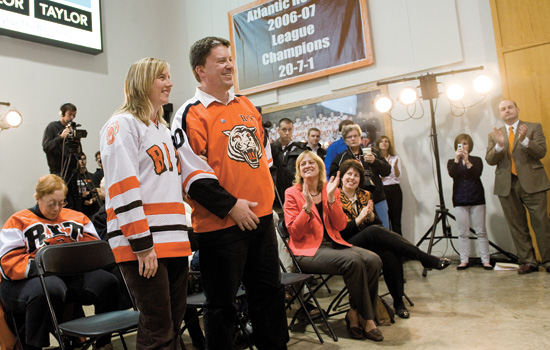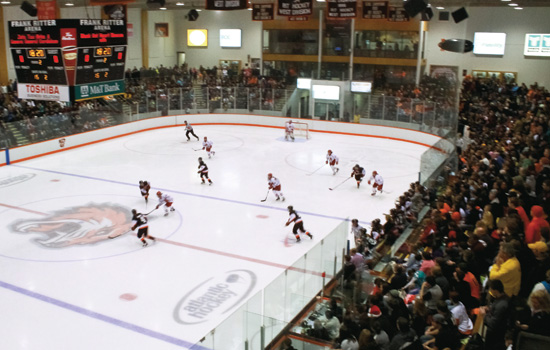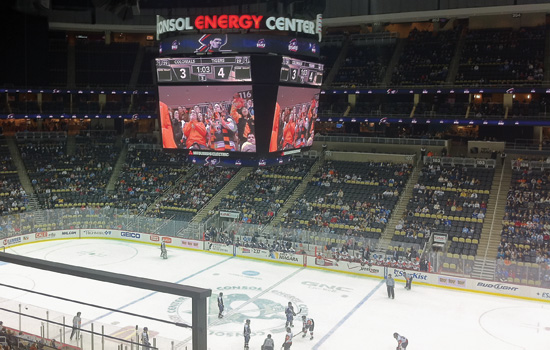The arena tour
New facility will draw on best practices
Therese Hannigan
The joy of RIT hockey fans is reflected on the high-definition video screen inside Pittsburgh’s Consol Energy Center on Dec. 30. The arena, where the Tigers beat Robert Morris 4-3, is one of several that officials are looking at for inspiration.
Leading up to the Tigers’ Dec. 30 match-up against Robert Morris University, expressions of awe could be easily detected. RIT hockey fans, strolling the corridors inside Pittsburgh’s Consol Energy Center, couldn’t help but marvel at the amenities.
The new home of the National Hockey League’s Pittsburgh Penguins opened last year and holds more than 18,000 seats. It includes a 4,000-square-foot team store, an impressive array of concessions, and glass-enclosed vistas overlooking the city skyline. And just above center ice, the arena’s state-of-the-art scoreboard, which flaunts high-definition video screens measuring 15 feet by 25 feet, is impossible to ignore.
Jim Watters counts himself as an admirer. RIT’s senior vice president for finance and administration beams as he recounts his experience that day. A Pittsburgh native, Watters enjoyed VIP treatment that included a tour of players’ facilities inside the arena by none other than Penguins head coach Dan Bylsma.
“It was a wonderful hour and a half with the coach,” Watters recalls with a smile, crediting RIT men’s hockey coach Wayne Wilson for arranging the opportunity. Bylsma, a former college hockey standout, played under then-assistant head coach Wilson during their time together at Bowling Green University.
But while enjoying the experience, Watters explains his inspection of Consol Energy Center remains part of a larger fact-finding mission with serious implications for the future of RIT hockey. Since the fall, members of the university’s administration have been touring arenas throughout the region to document best practices when it comes to enhancing the game day experience for players and fans. It follows RIT President Bill Destler’s announcement that the university will move ahead with plans to build a new hockey arena on campus.
Still, in a preliminary stage of planning, the questions now facing administrators include, “What should RIT’s arena look like? What amenities should it feature?” For answers, they’re examining facilities that include NHL venues—specifically in Pittsburgh and Buffalo—other college arenas, and even junior hockey locations in Ontario, Canada.
“We’re really coming up the learning curve in terms of what’s the latest thinking,” explains Watters.
To help finance the construction of a new arena, RIT launched Tiger Power Play—The Campaign for RIT Hockey, which targets alumni and other supporters of RIT men’s and women’s programs.
Stephen Schultz ’89 (computer science), co-founder and chief technical officer at Pictometry International Corp., along with his wife Vicki Schultz ’94, ’99 (business administration, MBA), are providing the campaign’s opening gift of $1 million. Schultz is co-founder of RIT’s colorful Corner Crew cheering section.
“I always said if Pictometry took off, I’d kick in toward a new rink,” Schultz says, “and I now have the opportunity to do so.”
With a campaign goal of $15 million, administrators are preparing a business model that will allow the university to finance up to $15 million in additional construction costs. Watters says a capacity of approximately 4,000 seats—double the size of Frank Ritter Arena—will generate additional revenue through ticket sales and enhanced concessions.
Dating back prior to last year’s NCAA Frozen Four tournament appearance, Tigers hockey has remained a hot ticket and has dictated the need for a new space.
Sellout crowds inside Ritter Arena are common, which prevent some students from attending certain games.
While a location for the arena has not been determined, factors for consideration include off-campus access, parking, and ease-of-access for students. That decision may come as early as this summer with a timeline on construction to follow.
But another important consideration will be how to create an environment that is uniquely RIT. Watters believes the Consol Energy Center achieves recognition of its local community, incorporating steel as a focal point of its architecture and showcasing displays that pay homage to Penguins folklore.
“Here is the life and the history of Pittsburgh incorporated into the building in a very tasteful, high-end way,” he states. “How can we do that at RIT?”
 Vicki Schultz ’94, ’99 and Stephen Schultz ’89 are providing the campaign’s opening gift of $1 million. A. Sue Weisler
Vicki Schultz ’94, ’99 and Stephen Schultz ’89 are providing the campaign’s opening gift of $1 million. A. Sue Weisler A capacity crowd of 2,100, a Division III women’s hockey regular season record, jammed Ritter Arena Jan. 21 when the top-ranked women’s team took on SUNY Plattsburgh. Dylan Heuer
A capacity crowd of 2,100, a Division III women’s hockey regular season record, jammed Ritter Arena Jan. 21 when the top-ranked women’s team took on SUNY Plattsburgh. Dylan Heuer














